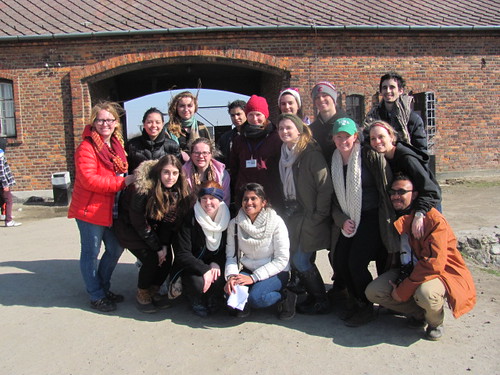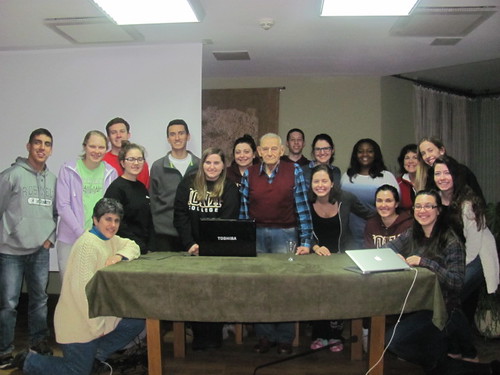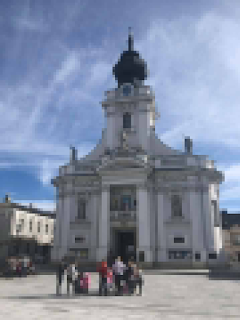 |
| Some of the paintings of Marian Kolodziej |
During one of our final days in Poland, we were able to look at the astonishing paintings of Marian Kolodziej, one of the first prisoners at Auschwitz I. After his liberation, Kolodziej became a set designer for theater productions and didn't want to share his experiences about the Shoah. However, after he suffered a stroke, he began to draw out his memories of the Shoah. These paintings are located under the Franciscan Center of St. Maksymillian. Although it was described as a preservation nightmare, the drawings themselves are absolutely terrifying. These paintings are primarily in black and white, drawing scenes from his time at the extermination camp of Auschwitz and throughout the Shoah. A lot of imagery is present in these paintings as well, utilizing symbolism in some of them to demonstrate how Kolodziej was feeling during this troubling time. I consistently found crosses and skulls littered throughout the drawings, symbolizing Christianity and death respectively. However, the most impactful thing for me that I saw while viewing these paintings were the humans themselves. The way the humans are drawn themselves initially threw me off, and I found myself very disturbed by some of the images that I saw. This disturbance was due to the way the humans were portrayed in these paintings. They seemed lifeless, skinny beyond all belief; their faces had a mix of fear and an acceptance of death. There was also a painting that showed the deterioration of a human during their time in the camps. This particularly disturbed me, as you can watch how a person deteriorates and eventually succumbs to the harsh conditions of these camps, and looking at their faces also shows you a thousand different emotions that they are feeling. Seeing these pictures reminded me of a movie that my class saw entitled The Last Days. The Last Days is a documentary film that covered the lives of five individuals that survived the Holocaust. We were able to listen and bear witness to their stories: one of the ladies had to eat diamonds continually in order to hide them from any guards once she got placed in Auschwitz-Birkenau. Another lady talked about how she celebrated the Shabbat in the latrines. Being able to hear these stories, I was ready to start pairing them with the pictures that I saw at the Franciscan Center of St. Maksymillian. This connection didn't come to me right away. However, in the back of my mind, I kept imagining the people in Kolodziej's paintings reenacting out the stories that I heard in The Last Days. I couldn't stop thinking about these images for a while, even after I returned to New York. Those images are alluring, mesmerizing, and terrifying all at the same time, and they leave an impression on your mind, forcing you to think about the events that happened in the Shoah. There are people out in the world who will try to deny that the Holocaust ever existed. After my time in Poland, I find it hard to believe that any of those claims are true.



















